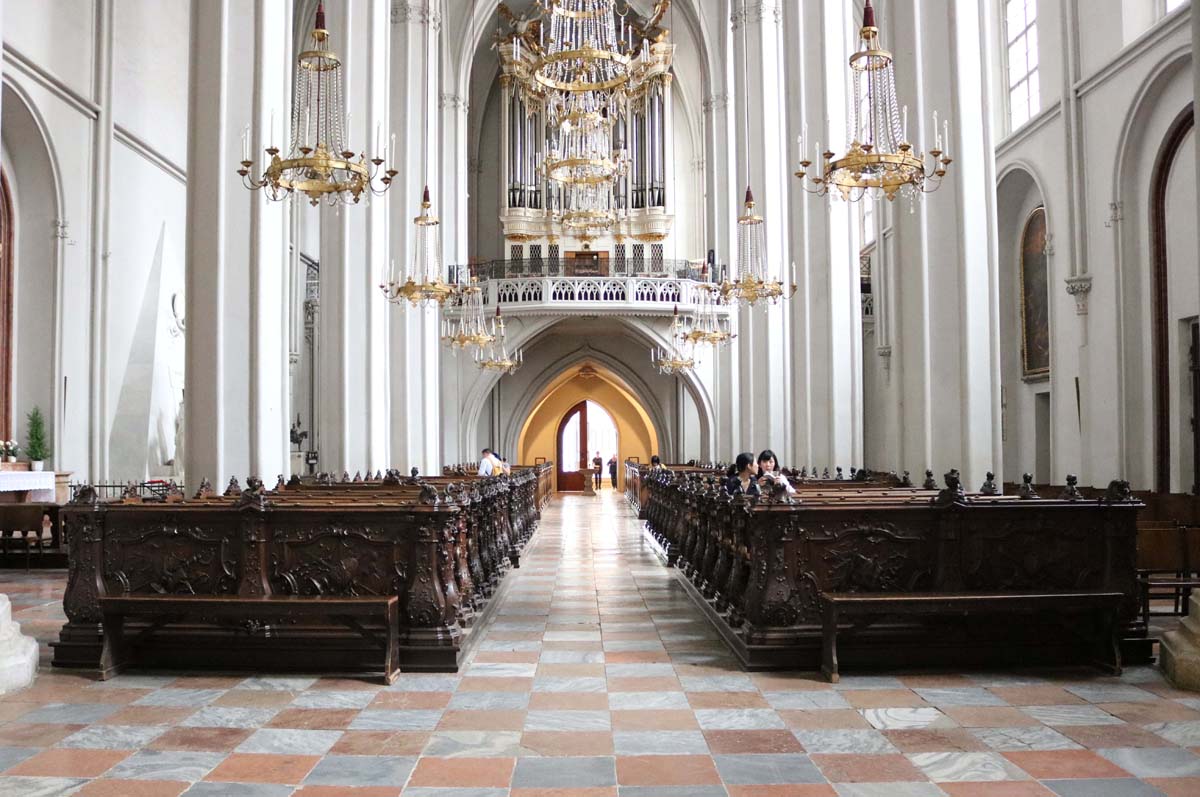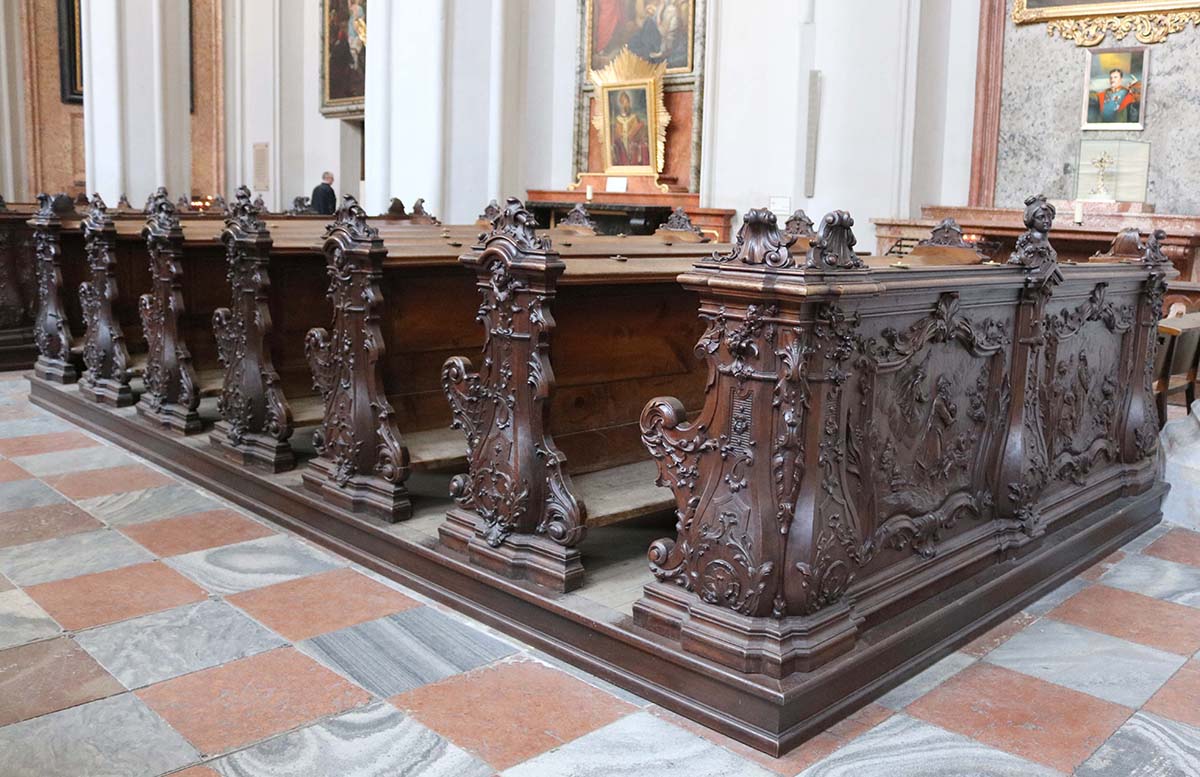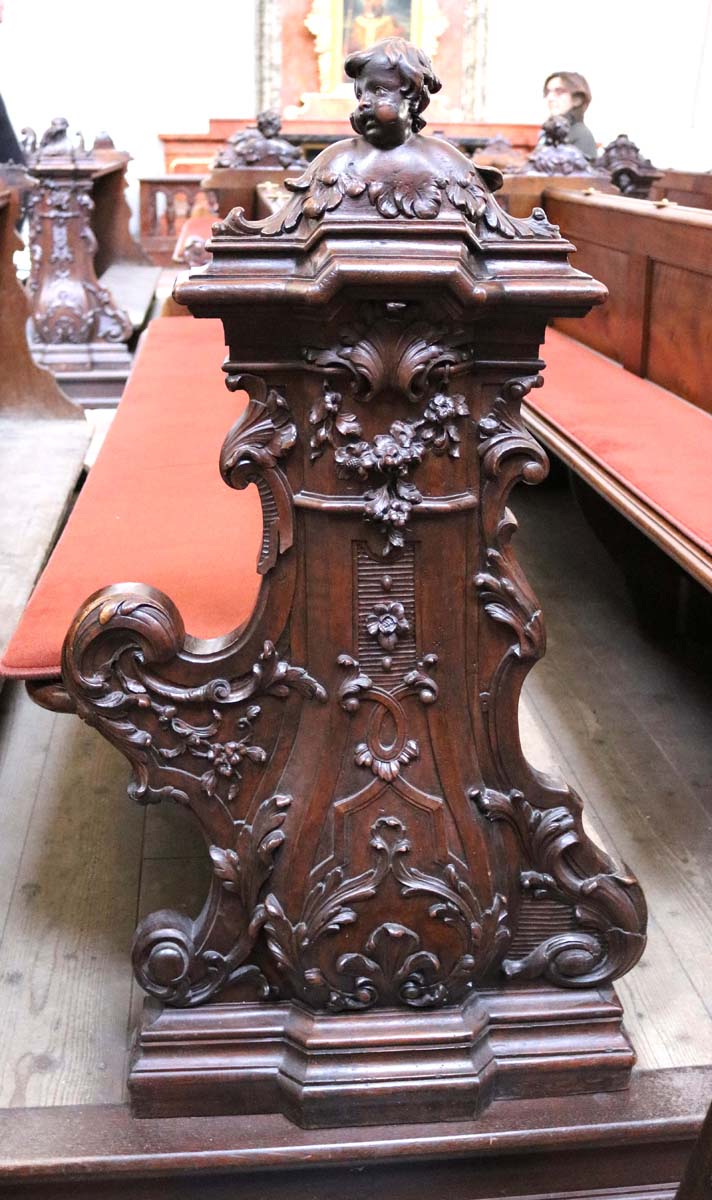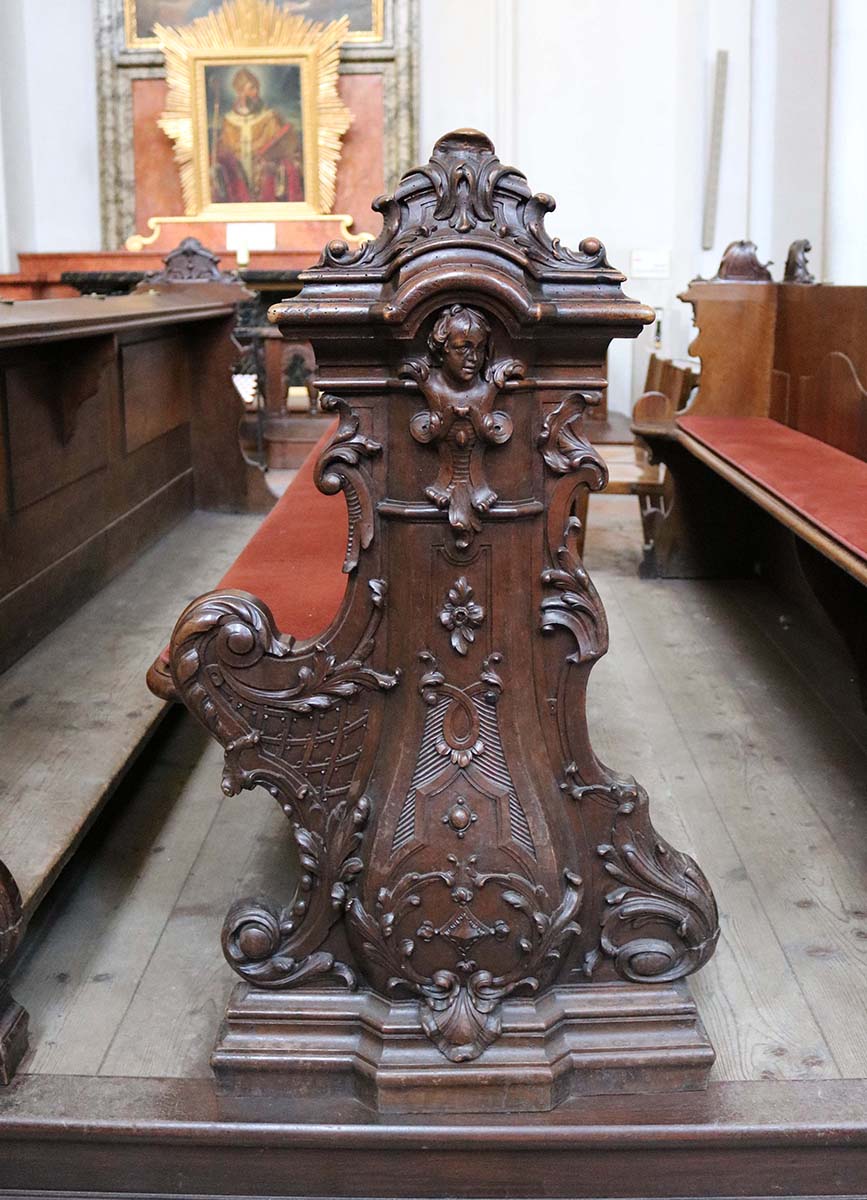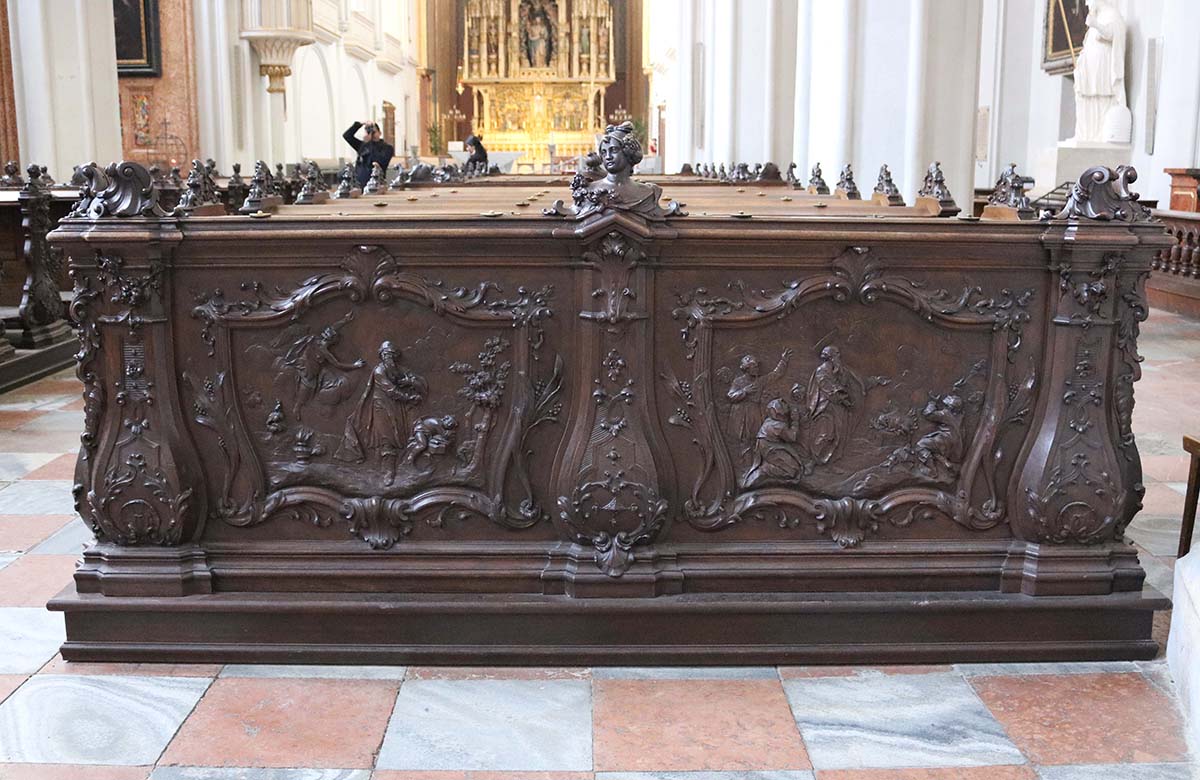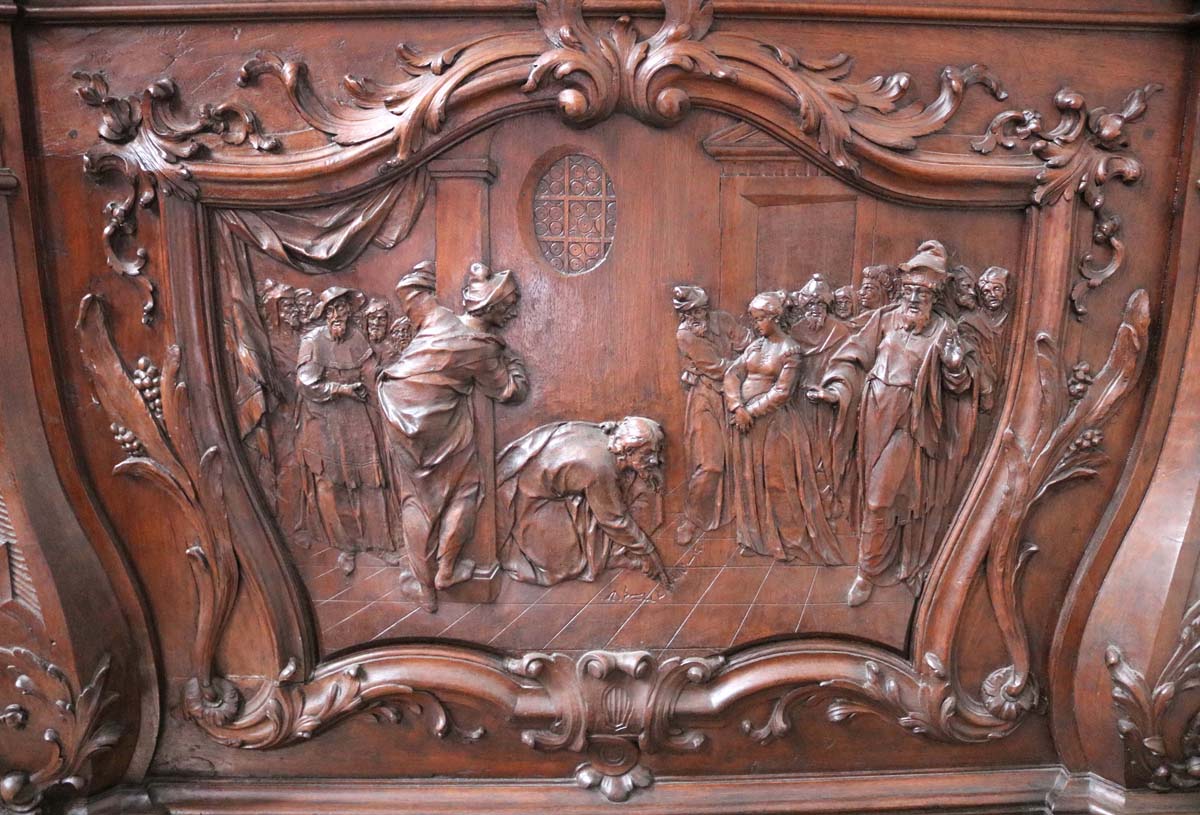Location
Austria, Vienna
Parish and Monastery Church of St Augustine (Augustinerkirche)
Original location:
Austria, Vienna
Benedictine Abbey Church of Our Lady of Monteserrato (Schwarzspanierkirche)
Artwork
Pewage of the Former Schwarzspanierkirche in Vienna
Type
Pew
Dimensions
Height: 111,5 cm, width: 287 cm, depth: 101 cm
Critical History
The pewage of the former Schwarzspanierkirche was attributed to Johann Baptist Straub when Johann Caspar Lippert published the earliest biography of the artist in 1772.1 The Abbot of the Benedictine Monastery de Monteserrato in Vienna, P. Anton Vogl von Krallern commissioned the wooden interior decoration, the church pews and the pulpit of the abbey church in 1730, when Straub was 26 years old. This commission was the first he undertook on his own, probably he employed also his younger brother Philipp Jakob, who stayed with him in Vienna from 1727 to 1733. Johann Baptist returned to Munich in winter 1734/35, which sets the date of the completion of his work. The consecration of the church was in 1739. During the Dissolution of the Monasteries under Emperor Joseph II in 1784, the former Abbey Church of Our Lady of Monteserrato was profaned, the furniture and artwork dispersed. At about that time the court architect Johann Ferdinand Hetzendorf von Hohenberg was renovating the Monastery Church of St Augustine situated within the imperial palace area of Vienna,; the church pews were brought there 1784 by personal order of Emperor Joseph II.2
The finely carved and decorated wooden pews show alternating decorations on the bench ends: row type A with a cherub on top, row type B with a female head under the segmental arch, topped with foliage and volutes. Prominent volutes mark the corner elements and lead over to the adjoining balusters of the facing, which also feature rich floral decoration and foliage. Three balusters, the central one with a large female bust on top, divide the facing in two and frame the figural reliefs. Eight reliefs are decorated with bundled trophies of cult objects and liturgical vestments from the Old and the New Testament. The other eight reliefs follow a complex topological programme and depict scenes from both testaments: The Binding of Isaac (Gen 22,1), The Burnt Offering by Noah (Gen 22,8), Moses Striking Water from the Rock (Ex 17,1), Moses Erecting the Bronze Serpent (Num 21,8), The Disputation (Lk 2,41), The Cleansing of the Temple (Mt 21,12; Mk 11,5; Lk 19,46), Christ and the Woman Taken in Adultery (Joh 8,3) and Christ's Charge to Peter (Mt 16,16). The scenes from the Old and New Testament do not correspond directly and therefore it is not possible to reconstruct the original setting of the pewage in the former Abbey Church of Monteserrato, as Gerhard P. Woeckel argued erroneously. According to Peter Steiner, it is even possible that some scenes are missing.3
Steiner considered the participation of Johann Baptist’s younger brother Philipp Jakob likely, especially regarding the figural reliefs and the cherubs; he referred to his early work in Graz, such as the reliefs for the Stadtpfarrkirche. At the same time, Horst Schweigert also pointed to the striking resemblance of Philipp Jakob's early reliefs in Graz to his brother’s commission for the Schwarzspanierkirche.4 In contrast to Johann Baptist Straub's other artwork of that time in Vienna, the pewage is described as nearest to Viennese tradition by Peter Volk.5 It may be compared to the church pews in St Peter (Matthias Steinl, 1716) or St Charles Borromeo's (Claude Le Fort du Plessy, about 1730/35) in Vienna.
Construction / Execution
The Baroque pews were installed in the nave of the Gothic church in four units or blocks, each with six rows. The benches, bench ends and facings of the wooden pewage with carved reliefs and figural decoration are made of hardwood, walnut with dark varnish, on the long prie-dieu are brass candleholders; the kneelers and the wooden platform – both made of softwood – seem newer than the walnut parts. Michael Bohr suggested that they were replaced at least once.6
Components
- Carpentry
- Author: Johann Baptist Straub (Wiesensteig ca. 1704 – Munich 1784)
- Completed: 1730 – 1734
- Patron(s): Anton Vogl von Krallern, abbot
- Technique(s): sawing
- Material(s): wood
- Sculpture
- Author: Johann Baptist Straub (Wiesensteig ca. 1704 – Munich 1784)
- Completed: 1730 – 1734
- Patron(s): Anton Vogl von Krallern, abbot
- Technique(s): wood carving
- Material(s): wood
Conservation-restoration
- 1996
Strategy: preserving varnish
Approach to the presentation of losses
Reconstruction of losses: partial
Treatment Description
Restoration of the pewage 1996 BDA Wien, Augustinerkirche, Akt 2842, 3, restorer Franz Bauer. Only inappropriate restorations should be removed, the surface preserved. According to Michael Bohr, Bauer complemented the head of an angel, that Gerhard P. Woeckel described as missing, probably lost before 1973.7
Images
- Parish and Monastery Church of St Augustine, nave with the pewage of the former Schwarzspanierkirche (Julia Strobl, 2018)
- St Augustine, pewage of the former Schwarzspanierkirche (Julia Strobl, 2018)
- Bench end, row type A with cherub (Julia Strobl, 2018)
- Bench end, row type B with female head (Julia Strobl, 2018)
- Facing of the backside with balusters, figural reliefs and female head (Julia Strobl, 2018)
- Christ and the Woman Taken in Adultery (Julia Strobl, 2018)
Catalogue entry prepared by Julia Strobl
Recommended citation: Julia Strobl, Pewage of the Former Schwarzspanierkirche in Vienna, in: TrArS – Tracing the Art of the Straub Family, 2018, (accessed 25/10/2025) URL
